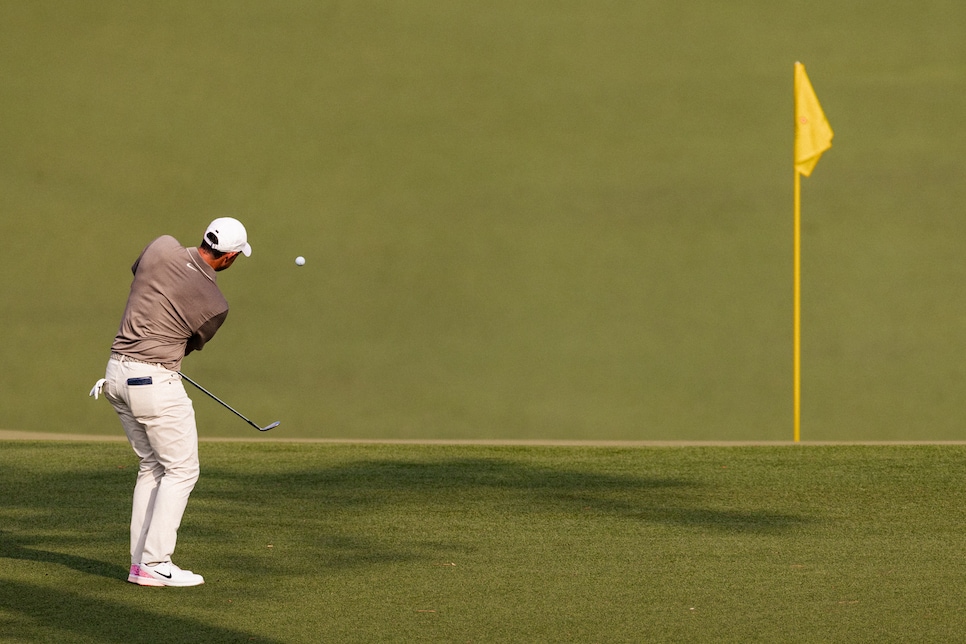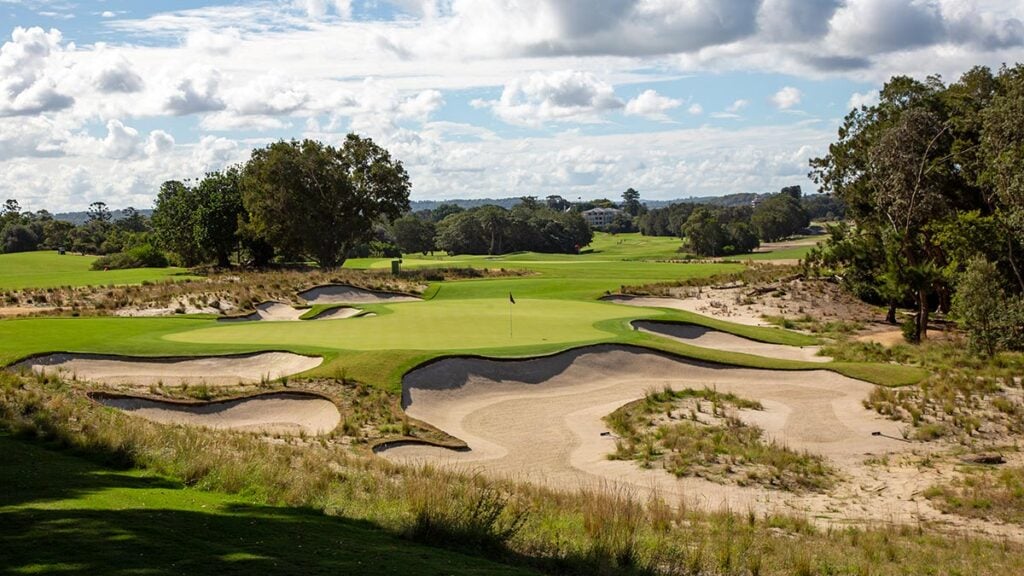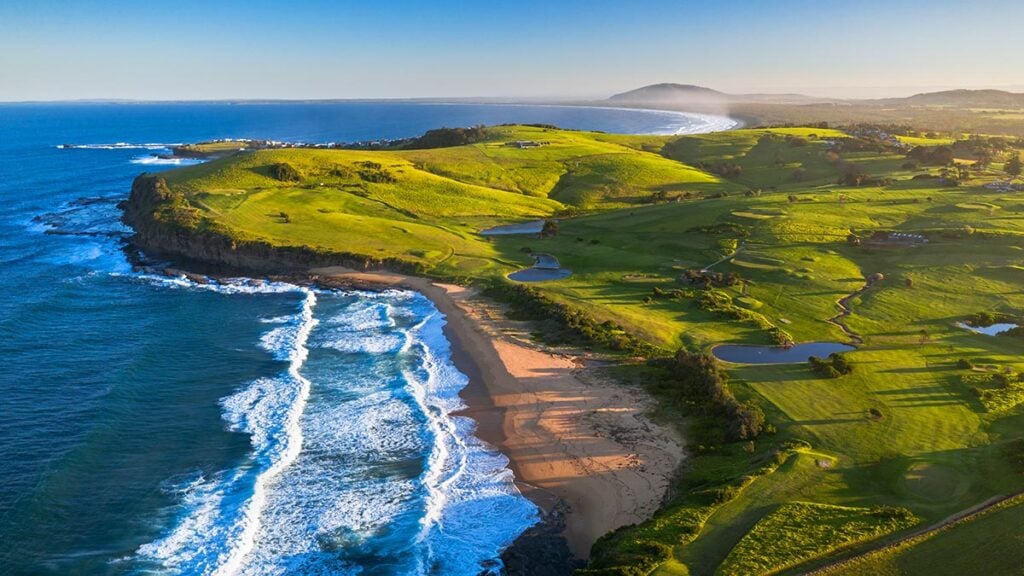AUGUSTA, Ga. — What’s going on with the 15th hole? If you’ve watched even a few minutes of the first two rounds of the Masters, you’ve seen guys bound a wedge shot over the green or chip the ball into the water, like Rory McIlroy did in the first round en route to a double bogey.
The stats back up these anecdotes. In Friday’s second round, the scoring average on the 15th hole was over par, at 5.14—an incredible statistic considering the 550-yard par 5 is reachable in two for nearly every player in the field. Only seven holes played more difficult on Friday—on a hole that traditionally is one of the four easiest. Even more remarkable is that players hit the green in regulation just 59 percent in the second round, which is hard to believe considering the tour average for all holes (not just par 5s) is about 65 percent.
RELATED: The changes at Augusta National’s 15th hole, explained
If this pace keeps up, the 15th will play among the toughest it ever has at the Masters. Players agree on the reason, too.
“That green is so much firmer than any other green, even the three newer greens,” McIlroy said after his second-round 66.
“I feel like that green has been firmer all week,” said Justin Rose.
“There’s some new greens out here—1, 8, 15, I think maybe one or two more. Those greens are noticeably firm on the first bounce,” said Tom Kim.

Stephen Denton
The firmness of the green is making both the second and third shots far more difficult than they already were. Longer approaches have less of a chance to hold the shallow green, which is only about 10 yard deep on the left side, where the hole location was on Friday. The already difficult wedge shot off a downhill lie that players have for their third was nearly impossible to hold the green on the left side due to this firmness.
Why is it so firm? After Hurricane Helene caused widespread damage at Augusta National and the surrounding region last September, the club rebuilt a few greens, including the 15th. While the specifics of how Augusta rebuilds greens is held secret, one superintendent explains why newer greens tend to be firmer than others.
“Newer greens are always going to be firmer just because they haven’t had time to develop that organic matter over time that they will naturally accumulate,” said Scott Griffith, the director of agronomy at the University of Georgia Golf Course in Athens and a 22-year member of the Golf Course Superintendents Association of America. Griffith clarifies that he is generally speaking about the agronomics at most courses and does not have specific insight into how Augusta rebuilds greens.
“That’s the reason why you have firm surfaces whenever you first do a renovation or you rebuild a green because you just have a pure grass stand on your sand based green,” he continued. “You don’t have that thatch layer that gives you that sponginess and softness. You haven’t developed that yet.”
RELATED: The death of the par 5
Over the course of a few years, Griffith says, a new green will begin to accumulate that thatch layer and play softer, but until then, expect a firm bounce.
With a firm green, the already-difficult wedge shot off the downslope at the 15th becomes even more tricky. According to stats from Data Golf, entering this week, the 90-yard wedge shot on No. 15 is the second-hardest shot at Augusta National relative to a tour player’s expectation. From that distance, players hit the green just 66 percent of the time, which is about the same percentage of a 185-yard approach at a typical tour course.

Stephen Denton
“ It’s always a hard one because you’re hitting off a downslope, and there’s just a such a fine margin with where to land it,” said J.T. Poston after the first round. “But on top of that, it’s a new green this year, so it’s especially firm.
“I landed it in a perfect spot, and I put as much spin as I possibly could on it from about 80 yards. In the air, I thought Ah, that’s perfect. And it landed a couple short of the pin, which normally you’re not trying to do there, and it bounced to 25 feet by it. It’s really hard to get it close with a wedge.”
This firmness also makes the chip shots from over the back of the green tougher than in the past. After Friday’s round, McIlroy explained why he hit such an uncharacteristically poor chip shot into the water on Thursday.
“I felt like I hit a pretty good chip shot,” he said. “I was really surprised at not so much the speed—I knew it was a fast chip. I’ve hit that chip a hundred times around this golf course. It was just more the first bounce was so firm.”
RELATED: Augusta National, reviewed: Our course raters reveal their opinions on the home of the Masters
Masters 101: Answering all your frequently asked questions
How to watch the 2025 Masters
Power Rankings: Every player in the Masters field, ranked
Tee times for Round 1 and Round 2
50 defining Masters Moments, ranked
The most memorable Rules issues in Masters history
Before and after photos of Augusta National’s tree loss from Hurricane Helene
Every course change ever made at Augusta National
A brief history of Masters prize money payouts
15 people who ended up in the Masters penalty box
The Champions Dinner Tell-All, from those inside the room
When Lee Elder desegregated the Masters
This article was originally published on golfdigest.com




